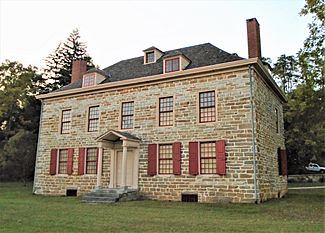Old Fort Johnson facts for kids
|
Fort Johnson
|
|

(2020)
|
|
| Location | 2 Mergner Rd., Fort Johnson, NY |
|---|---|
| Nearest city | Amsterdam |
| Area | 1 acre (0.40 ha) |
| Built | ca. 1749 |
| Architectural style | Georgian |
| NRHP reference No. | 72000858 |
Quick facts for kids Significant dates |
|
| Added to NRHP | November 28, 1972 |
| Designated NHL | November 28, 1972 |
Fort Johnson is a very old stone house in Fort Johnson, New York. It was built around 1749 by a famous person named Sir William Johnson. This house was more than just a home. It was also his office and a place where he traded goods.
Sir William Johnson lived here until 1763. Then, he moved to another home called Johnson Hall. His son, Sir John Johnson, lived in Fort Johnson after that. During the American Revolutionary War, the house was taken by a group called the local Committee of Safety. Today, Fort Johnson is a museum. The Montgomery County Historical Society takes care of it. It became a special National Historic Landmark in 1972.
Contents
What Fort Johnson Looks Like
Fort Johnson is in the middle of the village of Fort Johnson. It sits on the north side of NY Route 5. From the house, you can see the beautiful Mohawk River. The property is about one acre in size. A low stone wall surrounds the front and east sides.
The House's Design
The house itself is two and a half stories tall. It is made from strong limestone. The roof is shaped like a hip, which means it slopes on all four sides. Brick chimneys are on the sides of the house. Three small windows with pointed roofs stick out from the front of the main roof.
The front of the house has five sections. The main door is in the middle. It has a small porch with a pointed roof. This porch is held up by two round columns. Inside, the house has a central hallway. On one side, there is a living room and a study. On the other side, there is a large dining room. The kitchen is located downstairs in the basement.
History of Fort Johnson
Sir William Johnson came to what is now Upstate New York in 1738. He started a sawmill nearby. He also began trading with the local Mohawk people. Johnson built this house around 1749. This was after a war called King George's War had ended.
Fortifications and Influence
During the French and Indian War, the house was protected. A wooden fence, called a palisade, was built around it. Sir William Johnson was very important in dealing with the Native American tribes. He helped the colonial government work with the local Mohawk people. In 1756, he was named the "Superintendent of Indian Affairs." This meant he was in charge of relations with Native American groups for the king.
Changes in Ownership
In 1763, Sir William Johnson moved further west. He built Johnson Hall as his new main home. Fort Johnson then became the home of his son, Sir John Johnson. Sir John was a Loyalist during the American Revolutionary War. This means he supported the British king, not American independence.
Because the Johnsons did not support independence, their homes were taken. Both Fort Johnson and Johnson Hall were seized by the state. They were then sold to new owners. Over many years, Fort Johnson had different owners. In the 1920s, a man named John Watts DePeyster bought it. He then gave it to the Montgomery County Historical Society. They now run it as a museum, so people can visit and learn about its history.
See also

